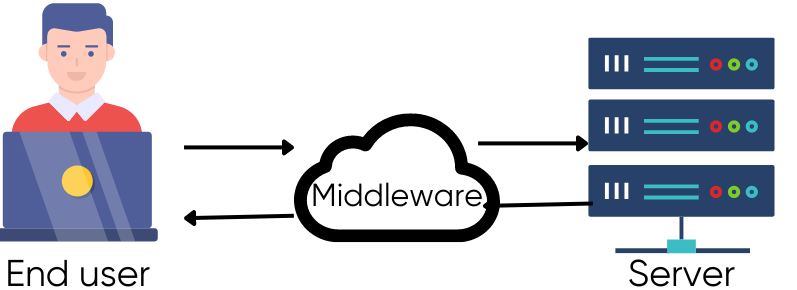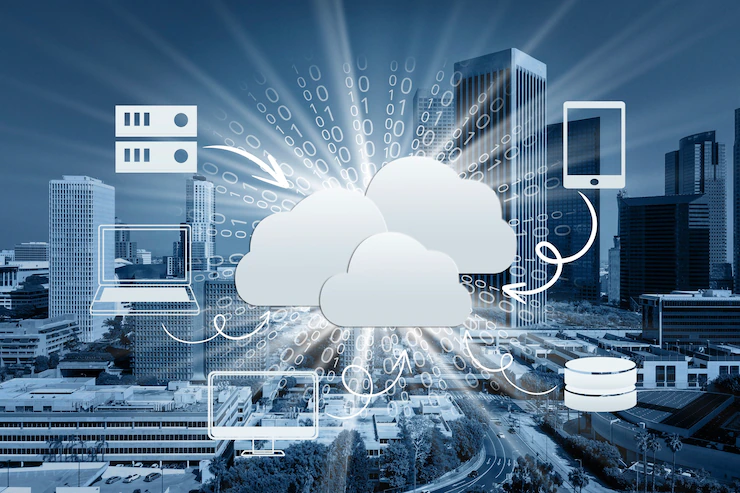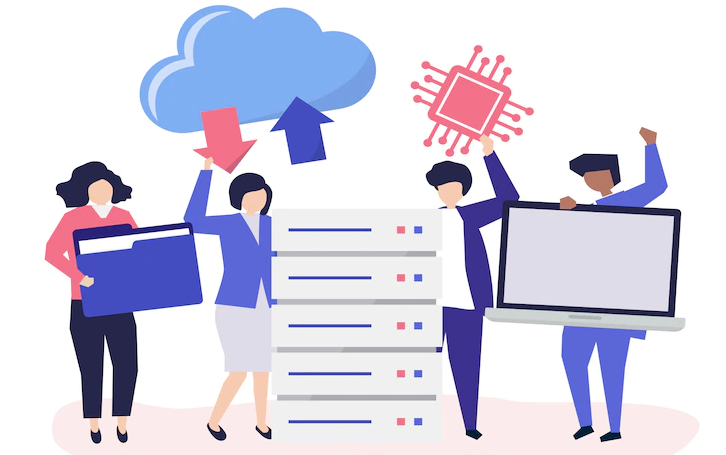Businesses in the modern era are continuing to embrace digitization. Such organizations use different hardware and software products to achieve their goals.
The hardware and software used in an organizational setup were designed differently, meaning they were not necessarily built to work together.
However, such an organization needs assurance that its hardware and software applications can work together.
What is Middleware?


Middleware can be defined as software that different applications use to communicate with each other. It thus acts as a hidden transition layer that enables data management and communication for distributed applications.
Through middleware, users can perform requests such as submitting forms on a web browser. Such software also allows the web server to return dynamic web pages on the user’s profile.
How does Middleware work?
Middleware allows developers to create applications without creating custom integrations whenever they need to connect data sources, application components, devices, or computing resources.
A middleware provides different services and applications that communicate with messaging frameworks such as representational state transfer (REST), JavaScript object notation (JSON), extensible markup language (XML), simple object access protocol (SOAP), or web services.
Middleware also enables components written in different languages, such as Java, Ruby, C++, PHP, and Python, to communicate with each other.
Why use Middleware?


Developers use middleware to achieve the following.
- Secure connections and data transfer. Middleware uses a network security protocol such as Transport Layer Security (TSL) to establish a secure connection from the front-end application to the data sources on the backend. Such software can also offer authentication capabilities, prompting the frontend application to request digital certificates or credentials (email/username and password).
- Configure and control integrations and connections. Middleware customizes a response from the service or back-end application based on the request of the client or front-end application request. A perfect example will be a retail setting where the middleware can use the location information in the HTTP request header or the IP address to sort product search results from a back-end inventory database.
- Manage traffic dynamically across distributed systems. A typical system may have fluctuations, such as the number of requests per second and traffic. An enterprise middleware can be used when traffic or requests spike to distribute client requests across various servers. Such a solution also comes in handy when multiple clients simultaneously access resources from the same data source.
Key Components of Middleware
A typical middleware application comprises various components that connect to create a data pipeline. These are the major components of middleware architecture.
- Management console. The software rules, middleware system’s activities, and configurations are found on the management console.
- Client interface. This is the outer part of the middleware software that communicates with the application. Developers utilize the functions provided by the client interface to perform various actions with the application.
- Middleware internal interface. This is like the internal glue that binds the different components of the software together. Different components use this internal interface to work together and achieve a common goal.
- Contract manager. The contract manager defines the rules for data exchange in middleware software. This is also the component that ensures that various applications abide by the rules set when exchanging data.
- Platform interface. This interface has software components that work with different operating systems. It is this interface that ensures that middleware is compatible with different platforms.
- Runtime monitor. A runtime monitor is tasked with continuously monitoring data movements within the system. This component detects and reports unusual behaviors for engineers to act on.
- Database manager. A database manager may not be available in all middleware systems. Such a component integrates with different data types.
- Session manager. Such a component stores data activity records for reporting and ensures a seamless flow of information.
Different Types of Middleware


#1. Message-oriented middleware (MOM)
MOM is a software infrastructure that allows messages to be received and sent over distributed applications. Message-oriented middleware transforms or translates messages exchanged between systems so that the targets can understand them. MOM also manages the routing of the messages to ensure they get the proper components and are in the right order.
#2. Application programming interface (API) middleware
API middleware has tools that developers can use to manage, create and expose APIs for their applications. API management platforms, API developer portals, and API gateways are examples of API middleware.
#3. Remote procedure call (RPC) middleware
RPC middleware is software that allows one application to trigger a procedure/ action in another application. Such applications could be running on the same or different computers.
#4. Transactional middleware
Transaction processing monitors (TPMs) are examples of transactional middleware. TPMs ensure that transactions move from one step to the next; where necessary, data can be deleted, changed, or added.
#5. Robotics middleware
A robot system can have software, firmware, and hardware sourced from different developers/ manufacturers. Robotics middleware simplifies the process of integrating these different products to work together.
#6. Device middleware
Device middleware has a set of connectivity and integration capabilities for developing apps for a certain operating system.
Examples of Middleware Platforms


Platform middleware is a system with tools and resources that support the application development process. Developers utilize platform middleware to share resources between applications. The following are examples of middleware platforms.
- Content management systems (CMS). A CMS is a system that enables users to create, modify, store and publish digital information. WordPress is a perfect example of an open-source content management system.
- Web servers. Web servers are systems that receive, respond to, and process application/ website requests. Amazon Lightsail is an example of a system that allows users to host web servers of lightweight applications.
- Runtime environment. A runtime works like a small operating system that allows the software to run. For instance, Java Runtime Environment is needed to run Java code/ applications.
- Containers. A container comes with a ready-to-deploy bundle of the application codes and all the necessary resources. Amazon Elastic Container Service (Amazon ECS) is an example of a service that allows developers to deploy and scale containerized applications.
Factors to consider when choosing a middleware platform
- Needs. There exist different types of middleware systems. You should thus determine your needs to determine what suits you best.
- Budget. You must evaluate how much you are willing to spend on such a system and how it influences your business processes.
- Level of security. The ideal middleware system should not have any vulnerabilities that may expose your data to malicious third parties.
- Reliability. Checking what other people have to say about the target middleware platform can help you make an informed decision.
Middleware important for Cloud Computing


Most organizations are now moving to cloud-native development to tap into the benefits of such environments.
However, such organizations must ensure consistent development, deployment, and management irrespective of whether they use a public cloud, private cloud, or on-premise environment.
Organizations are now turning to middleware, now offered as cloud services, to achieve this. Middleware thus simplifies development, deployment, and management while at the same time lowering development costs.
Middleware systems support application environments that work smoothly and consistently across distributed networks. Development teams can thus create secure apps fast as middleware supports DevSecOps strategies, software supply chain security, and automation,
What is the role of middleware in app development?
Every business’s dream is to have applications that run at scale. Building such applications calls for an environment that has unified functional capabilities. Middleware offers such an environment through the container, runtime, and integration layers.
Benefits of Middleware
- Innovative solutions. Your development team can use different products based on their strengths when developing applications.
- Faster development and scalability. The development teams do not have to create everything from scratch, as middleware provides a bridge to link different existing solutions.
- Efficient connectivity. You may have different pieces of hardware and software created by different engineers. Middleware system enhances connectivity within an organization and distributed systems.
Middleware Use Cases
Companies face a challenge in today’s digital business world: different hardware and software don’t always work well together. Middleware is like a secret bridge, making sure these systems can talk and work together smoothly.


- Developing New Applications with Ease: Middleware makes it easier to build new apps. Developers can use essential features like web servers and single sign-on without struggling to make them fit together.
- Optimizing Existing Applications for the Cloud: Once stuck in one place, older apps can now move to the cloud thanks to middleware. This change boosts performance and makes them more flexible.
- Comprehensive Integration for Business Growth: Connecting different systems gets complicated as businesses grow. Middleware acts like glue, linking everything together smoothly, which helps the business to keep growing.
- Harnessing the Power of APIs: Middleware uses APIs, tools that let different software communicate. This speeds up development and improves how various software works together.
- Efficient Data Streaming for Dynamic Systems: Middleware allows data to flow smoothly between applications. This makes the whole system more efficient, automating tasks and managing resources better.
- Addressing Security Concerns: Middleware is vital for secure data sharing. It uses special security rules to ensure data moves safely from one place to another.
- Configuring and Controlling Integrations: Middleware can tailor information based on user needs. For example, online shopping can show nearby products based on the user’s location.
- Dynamic Traffic Management Across Systems: Middleware is excellent for handling loads of online traffic. It makes sure that user requests are spread out evenly across different servers.
Middleware is vital for businesses to manage their software systems effectively. It helps in development, ensures smooth operation, and keeps data safe. By using middleware, companies can get the most out of their technology.
Middleware’s role in business is becoming more and more important. As companies aim for growth and efficiency, middleware will be even more crucial in the digital world.
Learning Resources: Middleware
#1. Middleware Software A Complete Guide
Middleware Software A Complete Guide helps developers uncover middleware software challenges and develop better solutions. This resourceful book is available in both Kindle and Paperback versions.
#2. Introduction to Middleware
Introduction to Middleware is a book that explains different middleware technologies and the concepts they are based on. The book is available in 3 formats; Hardcover, eTextbook, and Paperback.
#3. Middleware and Cloud Computing
Middleware and Cloud Computing is the right book to read if you want a deeper understanding of Cloud Computing and Middleware. This amazing book is available in both Kindle and Paperback versions.
Author’s Note
The role of middleware can’t be overlooked in the modern world, where businesses are creating systems and also digitizing most of their services. Using middleware has improved productivity as developers don’t have to set up configurations or create some systems from scratch. We can only expect more middleware systems to continue being introduced as organizations focus on scalability and efficient production.
Conclusion
Middleware systems are important irrespective of whether you are working on cloud computing or any other environment with distributed applications. Middleware makes it easy for different hardware and software components to work harmoniously, irrespective of the design differences.
Si quiere puede hacernos una donación por el trabajo que hacemos, lo apreciaremos mucho.
Direcciones de Billetera:
- BTC: 14xsuQRtT3Abek4zgDWZxJXs9VRdwxyPUS
- USDT: TQmV9FyrcpeaZMro3M1yeEHnNjv7xKZDNe
- BNB: 0x2fdb9034507b6d505d351a6f59d877040d0edb0f
- DOGE: D5SZesmFQGYVkE5trYYLF8hNPBgXgYcmrx
También puede seguirnos en nuestras Redes sociales para mantenerse al tanto de los últimos post de la web:
- Telegram
Disclaimer: En Cryptoshitcompra.com no nos hacemos responsables de ninguna inversión de ningún visitante, nosotros simplemente damos información sobre Tokens, juegos NFT y criptomonedas, no recomendamos inversiones


